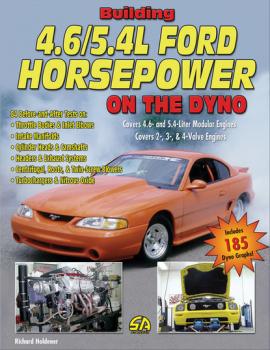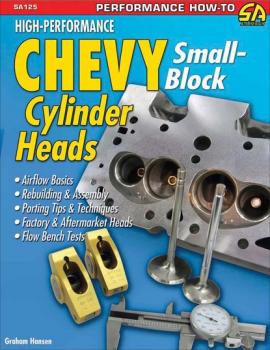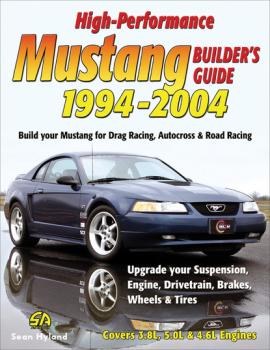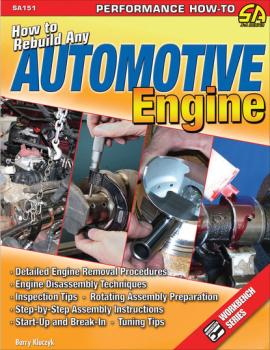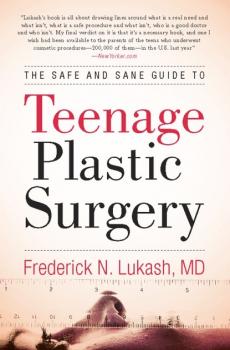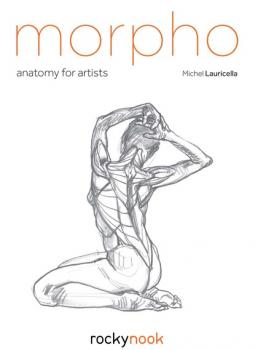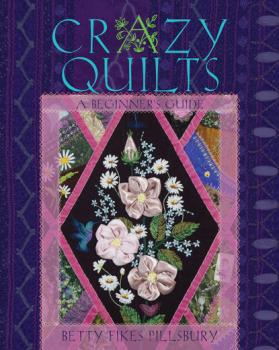Сделай Сам
Различные книги в жанре Сделай СамBuilding 4.6/5.4L Ford Horsepower on the Dyno
The photos in this edition are black and white.<p>The 4.6- and 5.4-liter modular Ford engines are finally catching up with the legendary 5.0L in terms of aftermarket support and performance parts availability. Having a lot of parts to choose from is great for the enthusiast, but it can also make it harder to figure out what parts and modifications will work best. Building 4.6/5.4L Ford Horsepower on the Dyno takes the guesswork out of modification and parts selection by showing you the types of horsepower and torque gains expected by each modification. <p>Author Richard Holdener uses over 340 photos and 185 back-to-back dyno graphs to show you which parts increase horsepower and torque, and which parts don't deliver on their promises. Unlike sources that only give you peak numbers and gains, <i>Building 4.6/5.4L Ford Horsepower on the Dyno</i> includes complete before-and-after dyno graphs, so you can see where in the RPM range these parts make (or lose) the most horsepower and torque. Holdener covers upgrades for 2-, 3-, and 4-valve modular engines, with chapters on throttle bodies and inlet elbows, intake manifolds, cylinder heads, camshafts, nitrous oxide, supercharging, turbocharging, headers, exhaust systems, and complete engine buildups.
High Performance Chevy Small-Block Cylinder Heads
The photos in this edition are black and white.<p>Any professional performance engine builder will likely tell you the most powerful and important component in an engine are cylinder heads. If you can afford to invest serious money in one component for a street engine, in most cases it should be a set of cylinder heads. While the small-block Chevy engine has been well-chronicled, specific in-depth information on this important component has been more elusive. This book shows you how to choose the best cylinder head for your application. It covers both Gen I and Gen II small-block Chevy versions, occasionally touching on the Gen III and Gen IV production versions. This book taps into some of the best small-block Chevy cylinder head resources this country has to offer with a combination of insight and best estimates, because much of what we know about port design and airflow management falls under the category of art rather than science. <p><i>High-Performance Chevy Small-Block Cylinder Heads</i> is designed exactly like its predecessor, <i>High-Performance Chevy Small-Block Cams & Valvetrains</i>, in that it starts with the basics and works into more in-depth concepts and variables in an attempt to uncover all those subtle nuances that make up the small-block Chevy. It features airflow basics, extensive flow bench tests (using the Superflow 600 bench), information on production and aftermarket heads, rebuilding and assembly, and basic porting techniques.
High-Performance Mustang Builder's Guide: 1994-2004
The photos in this edition are black and white.<p>Before the introduction of the 05+ models, 1994-'04 Mustangs represented a high-water mark for late- model Mustang enthusiasts. From the '94-'95s with the 5.0L, through the '96-'04 models with the 2- and 4-valve 4.6Ls, to the Bullitt, Mach 1, and factory supercharged '03-'04 Cobras – never before has such a range of highly modifiable performance cars been available. These Mustangs were great performers straight from the factory, but they can be even better with the right combination of performance parts. Regardless of which '94-'04 Mustang you start with, the availability of high-performance parts is impressive. You can build your Mustang for drag racing, road racing, or improved street performance – and <i>High- Performance Mustang Builder's Guide 1994-2004</i> will show you how! Author Sean Hyland uses over 300 photos to explain how to upgrade your Mustang's engine, suspension, chassis, transmission, rear end, brakes, and body. There's even a special chapter on getting active in various forms of organized racing.
How to Rebuild Any Automotive Engine
The photos in this edition are black and white.<p>There comes a time in every automobile's life when the engine just doesn't perform as it should anymore. It may be burning oil, it may be leaking, the compression may be so low that it only starts on cold days, or maybe it just isn't very efficient anymore. When all of this happens, you have to decide whether to just dump the car and replace it, or add some new life to your old car by rebuilding the engine. <p>Rebuilding the engine in any used car, much less a classic, seems like a much more attractive option when you can save a lot of money by doing it yourself. Sometimes the savings are the difference between keeping your car or letting it go. If you want to keep you car running strong and lasting for years, this is the book for you. <p>A part of CarTech's Workbench Series, <i>How to Rebuild Any Automotive Engine</i> covers the basics of any engine rebuild in more than 400 photos of step-by-step instruction. Subjects covered include preparation and tool requirements, engine removal, engine disassembly, machine work and clean-up, short-block assembly, final engine assembly, installation, start-up, and break in. Also visited are the options of purchasing crate engines, remanufactured engines, and performance upgrades. This book applies to all cars on the road that feature an internal combustion engine. Spend a little on this book and save hundreds of dollars down the road.
The Safe and Sane Guide to Teenage Plastic Surgery
The Safe and Sane Guide to Teenage Plastic Surgery, by Dr. Frederick N. Lukash, is the only complete guide to this ever-expanding phenomenon. Written by the American Society of Plastic Surgery‘s acknowledged expert and official media spokesperson on pediatric and adolescent plastic surgery, this book answers those tough questions parents of potential teenage plastic surgery candidates have: Will surgery increase their child’s self-esteem and help them fit in better? Or is it a dangerously easy solution to deeper issues? When is surgery right, and when is it not?Interviewed in The New York Times and featured on Discovery Health among many other media outlets, Lukash guides families through every step of the process, from finding the perfect-fit doctor and applying for medical insurance to surgery and finally to recovery and a changed life. A virtual, free consultation with a renowned expert in the field, the book doesn’t just offer easy solutions to teen’s body-image problems but helps parents understand the emotional, psychological and social dilemmas involved.Complete with action plans, real-life stories and pictures, The Safe and Sane Guide to Teenage Plastic Surgery offers advice on what can, can’t and shouldn’t be done—and on how to spot the doctors who will exploit a teen’s fragile sense of self-esteem as well as his or her parent’s pocketbook. Most important, Lukash provides a useful red light/yellow light/green light guide for considering teen plastic surgery.
The Happy Herbivore Guide to Plant-Based Living
Every day, Lindsay S. Nixon, author of the popular Happy Herbivore blog and cookbook series, is sent dozens of questions from readers about living a plant-based life: What do you do in social situations outside of the home? At restaurants? Potlucks? Weddings? What about traveling and vacation? How do you deal with negativity and naysayers? How do you talk to your family and friends about this way of life?Nixon has put together a practical guide to address questions like these and to help with the many other challenges that come with a plant-based or vegan diet. Whether you’re already living the Happy Herbivore lifestyle or simply thinking of switching to a plant-based way of life, The Happy Herbivore Guide to Plant-Based Living is for you.
The Munchkin Book
With 18 exclusive Munchkin® game rules!By gently – and sometimes not so gently – mocking the fantasy dungeon crawl and the sacred cows of pop culture, the Munchkin card game has stabbed and sneaked and snickered a path to the pinnacle of success. Along the way, it has sold millions of copies, been translated around the world, and spawned more than two dozen sequels and supplements.More fun than a Chainsaw of Bloody Dismemberment and more useful than a Chicken on Your Head, The Munchkin Book is a lighthearted and suitably snarky celebration of all things near and dear to the munchkin heart, featuring exclusive content from:Munchkin’s designer and Steve Jackson Games president Steve JacksonMunchkin’s signature artist John Kovalic (creator of web comic Dork Tower)Steve Jackson Games’ “Munchkin Czar” Andrew HackardCEO of Steve Jackson Games Phil ReedThe Munchkin Book also includes a foreword by New York Times bestselling author and Forgotten Realms creator Ed Greenwood, an introduction by editor James Lowder, and contributions from notable mavens of geek culture, including:Andrew Zimmerman Jones • David M. Ewalt • Jennifer Steen • Joseph Scrimshaw • Randy Scheunemann • Jaym Gates • Dave Banks • Matt Forbeck • Christian Lindke • Bonnie Burton • Colm Lundberg • Liam McIntyreSteve Jackson Games, based in Austin, Texas, has been publishing games, game books, and magazines since 1980. Its best-selling game is Munchkin, with well over 2 million copies of the games and supplements in print worldwide. Other top sellers are GURPS (the Generic Universal RolePlaying System), Zombie Dice, and Illuminati. Past hits have included Car Wars and Toon. Steve’s very first game, Ogre, recently drew almost a million dollars’ worth of Kickstarter support for a super-deluxe edition to be released in 2013.
Toxic Beauty
Splashy ads and commercials for personal care products are everywhere we turn, promising to keep our appearances fresh and our partners satisfied.<BR><BR>But do consumers really know what they’re applying to their faces and bodies in their quests for youth and beauty? Do they know the health risks they’re taking by simply applying lipstick, face moisturizer or deodorant? Toxic cosmetics and personal care products clutter the shelves at retail stores everywhere, and consumers don’t know the avoidable risks they’re taking by following a simple beauty regimen.<BR><BR>Written by Dr. Samuel S. Epstein, a founder and chairperson of the Cancer Prevention Coalition, Toxic Beauty gives the lowdown on salon safety, health risks hiding in everyday products, how we put our children in danger and more. Toxic Beauty will also educate you and your family on easily implemented solutions through the use of a variety of positive alternatives.<BR><BR>Through the help of Dr. Epstein and Toxic Beauty, you can protect yourself from the possible long-term effects of a simple beauty product.
Morpho
In this book, Michel Lauricella presents both his artistic and systematic methods for drawing the human body—with drawing techniques from the écorché (showing the musculature underneath the skin) to sketches of models in action. In more than 1000 illustrations, the human body is shown from a new perspective—from bone structure to musculature, from anatomical detail to the body in motion. <i>Morpho</i> is a rich, fascinating, and helpful book that can go with you everywhere on your sketching journey.
Crazy Quilts
Textile artist and instructor Betty Fikes Pillsbury has won hundreds of awards for her homages to the elegance of Victorian crazy quilting. Grounded in traditional methods but crafted with elements of whimsy, each piece stands on its own as a work of art. In this definitive guide, Pillsbury shares her methods for piecing, embroidering, and embellishing. Her instructions equip readers at any level of quilting skill to use those techniques to express their own visions. Encouraging her readers to see functional and artistic possibilities beyond quilts (wall hangings, purses, and pillowcases are just some of the options), Pillsbury shows them how to make each work by hand, the slow cloth way. An inspiring primer for beginning and experienced quilters alike, this meticulously illustrated how-to book is far more expansive than previous guides. Pillsbury—a master of the form—shows us why crazy quilting belongs firmly in the twenty-first century.
